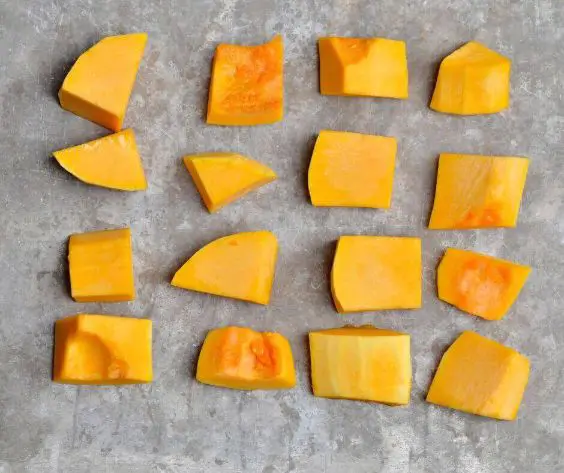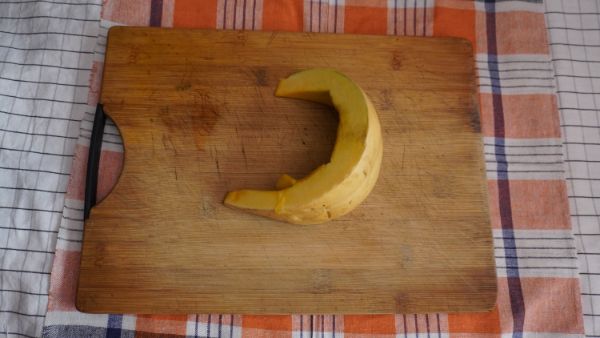Butter squash is hands down one of the most sought-after varieties of winter squash. Despite the seasonal name, it’s available all year round in the US. However, it’s also true that this produce is associated with cool, crisp weather and cozy dishes.
A month ago, I made penne pasta with sausage with butternut squash and chard for my niece’s birthday dinner. So, staying true to my idiosyncrasy, I overestimated the quantity of butternut squash required for this recipe.
This creamy delight was an instant hit at the dinner table, but I was left with a good amount of cubed butternut squash in the kitchen with no idea what to do next.
Cutting to the chase, I heeded my mother’s advice and successfully stored cut butternut squash for over a week! While looking for tips online, I also came across a rather interesting technique that I’m yet to try. I’ll fill you in about that too.
Let’s begin!
Table Of Content
How To Store Cut Butternut Squash?
Cut butternut squash should be stored in an airtight container in the fridge’s crisper drawer where the temperature is maintained between 32-40 degrees Fahrenheit. The produce will remain fresh for at least a week when stored this way.
Ensure the squash cubes are dry before storing them since moisture accelerates decay. Also, the lid should be tightly sealed as exposure to air will oxidize the veggies, negatively affecting their appearance and smell.
You can also wrap the squash cubes securely in plastic wrap or toss them in a resealable plastic bag. Having said that, I don’t know if it’s scientifically correct, but I feel that airtight containers provide more protection than any other kind of cover.
For instance, a tightly sealed lid shields better than plastic when protecting from ethylene gas, which quickens the metabolism and shortens the produce’s life.
How To Tell If Cut Butternut Squash Has Gone Bad?
If there’s slimy, stinky liquid oozing from the squash, it means the flesh has gone bad. The cubes will look shrunken and wrinkled and can also develop molds and blemishes.
Sometimes, the squash cubes will rot away even when you’d put in the best effort. In that case, it’s safe to toss the cubes in the bin to avoid the risks of food poisoning.
A New Technique Of Storing Cut Butternut Squash?
As I said earlier, I found this new technique on the internet to store cut butternut squash. Let me quickly tell you about it.
The first step is to place the cut cubes in a glass container that comes with an airtight lid.
Next, pour around ¼” of cold water on the bottom. Add water sparsely – you just need a little to keep the squash from drying. If you overdo it, they will get soggy.
Now, lay one or two kitchen towels on top of the cubes. Cover as much as you can. Finally, place the lid on and store it in the fridge.
Apparently, butternut squash stored this way stay fresh for around 10 days.
Disclaimer: I haven’t tried this technique. But the author on the forum swears by it. They say it is the only way they ever use to store cut butternut squash.
If you try this method, let us know how it pans out in the comment section below.
If you like butternut squash as much as I do, you’ll find it handy to have some ready on the go for your grain bowls, pasta, and so much more. You’ll have to roast some cubed pieces and store them in the fridge for this.
Cubed And Roasted Butternut Squash Recipe
Nothing feels more like autumn than a sheet pan teeming with roasted butternut squash for me. There are two ways you can roast them – with or without skin.
For skin-on roasting, brush the cubes with olive oil and bake at 375 degrees F with the flesh side facing down. Add seasoning as you wish. They should be nice and toasty in the next 30 to 40 minutes.
For skin-off roasting, you need to bake them at 400 degrees F for 30 to 40 minutes. Remember to stir once about halfway through.
I only use salt, pepper, and red chili flakes for seasoning, so they don’t manipulate the flavors when used in other meals.
You can now use cubed and roasted butternut squash in curries, tacos, pasta, porridge, and so much more.
Toss them in an airtight container and place them in the crisper drawer for storage.
Before I tell you how to freeze cut butternut squash for long-term storage, let’s quickly go through the technique of storing the whole vegetable in its intact form.
How To Store Whole Butternut Squash?
Unlike most vegetables, whole butternut squash doesn’t belong in the crisper drawer. Instead, they should be stored in a dark and dry place where the temperature is just below 55 degrees F.
A cellar or a cool pantry works best. This way, the squash will remain fresh for up to 2 months.
If you store them in the fridge to extend shelf-life, it could negatively affect the texture.
Now, let’s find out how to freeze cut butternut squash. It’s super easy.
How To Freeze Cut Butternut Squash?

You don’t have to blanch the vegetable first. Lay the pieces on a sheet pan and flash-freeze them. Flash freezing is required, so the cubes don’t stick to each other later.
Once frozen all the way through, transfer them to an airtight container or a ziplock bag and put them back in the freezer. They will remain good for over a year, but it is best if used within 12 months.
Another excellent option is to roast and puree your butternut squash before freezing. You can then portion it out using an ice cream scooper for the next 3 to 6 months.
By the way, butternut squash and pumpkin puree are almost indistinguishable in taste.
Buy The Freshest Butternut Squash Every Time

Butternut squash is famous for its beautiful golden color and smooth texture. Choose the ones without soft spots, nicks, and bruises. A good squash should feel quite heavy relative to its size.
Here are four pointers to keep in mind the next time you buy butternut squash:
Buy the variant with at least an inch of stem on it. If it’s been destemmed, it will go bad pretty quickly.
The weight is indicative of freshness. Too light means it still needs to fully mature. Buy the heavier one.
Observe the skin for blemishes, dark spots, and soft areas. If your fingernail goes through easily without pressure, the squash is too soft. Also, look for a matte, non-waxy exterior.
Opt for darker colors; if it’s too green or pale or doesn’t have much color, it’s not ripe yet. Look for darker orange and amber colors.
Recommended Readings!
How To Store Cut Asparagus? Leaching Nutrients and Flavor Loss?

